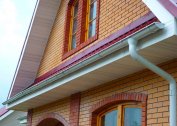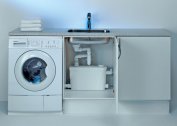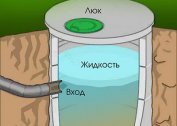The color designation is used to indicate the types of pipes used in certain conditions. When choosing, the place to lay the pipeline is taken into account, whether inside the house or outside, climatic conditions and temperature difference during operation.
Gray
 Gray pipes are intended for use inside the building in the absence of temperature changes and the possibility of mechanical damage. Polypropylene is used as the material of manufacture. Characteristics of gray pipes when used as sewers:
Gray pipes are intended for use inside the building in the absence of temperature changes and the possibility of mechanical damage. Polypropylene is used as the material of manufacture. Characteristics of gray pipes when used as sewers:
- able to pass liquid whose temperature does not exceed 60-75aboutC, briefly withstand 90-95aboutWITH;
- the temperature of the room where the pipe is located must not fall below 0aboutWITH;
- during operation they are not corroded and do not emit substances harmful to health;
- are deformed with a slight effort of 50-75 kgf / sq.m., the thickness of the polypropylene wall is 2.7 mm;
- not applicable for underground laying;
- differ in low cost.
The most common type of pipe is suitable for laying part of the sewage system, which passes inside the house, due to the fact that the technological characteristics of the material fully meet the requirements. It is not recommended to use this type of product when forming the outer pipeline.
Redheads
 The red pipes, which stand out against the rest with their bright colors, are used to create an external sewage network. The walls of the product are sufficiently rigid, they withstand a large level of external pressure. To extend the life of the sewer pipeline, it is recommended to use red-colored pipes.
The red pipes, which stand out against the rest with their bright colors, are used to create an external sewage network. The walls of the product are sufficiently rigid, they withstand a large level of external pressure. To extend the life of the sewer pipeline, it is recommended to use red-colored pipes.
Products are made from polyvinyl chloride. Strength pipes are divided into classes according to which the magnitude of the load varies:
- class L withstands loads up to 2 kN / sq.m;
- class N withstands loads up to 4 kN / sq.m;
- class S withstands loads up to 8 kN / sq.m.
Also, products of red color are classified by wall thickness:
- SN4 has a thickness of 3.0 mm;
- SN8 has a thickness of 3.3 mm.
The PVC pipe does not tolerate temperature increases, while the operating range is limited to 40-60aboutC. Nevertheless, the negative ambient temperature does not affect the characteristics of the material.
Red products are able to withstand the weight of the soil when laying the pipeline to a depth of 2 to 8 meters, depending on the class of the pipe. It is not recommended to arrange structures under roads, since there is a high probability of deformation, which can lead to precipitation in wastewater and the formation of congestion.
Red-colored pipes have a number of disadvantages:
- destruction ability under the influence of acid and oil drains;
- as the temperature rises, the PVC pipe begins to lengthen.
Pipes are made smooth or corrugated. Corrugated products have a large surface area, so due to the redistribution of pressure from the soil, they show increased resistance to stress. The cost of this category of pipes is slightly higher than gray products for internal use.
Green
Products painted green are used to install the drainage system underground. A distinctive feature of green pipes is the ability to bend during subsidence. In this case, the pipes exhibit resistance to temperature changes. The surface of the product has perforation, which allows moisture to enter. Manufactured products are sometimes equipped with a layer of geotextile, acting as a filter.
Whites
 White products are used when laying sewers indoors.They are used most often in places where gray products look unattractive, since white pipes have an aesthetic appearance. At the same time, in terms of their strength characteristics, white products are not inferior to gray pipes. Distinctive advantages include the possibility of noise absorption and low thermal conductivity.
White products are used when laying sewers indoors.They are used most often in places where gray products look unattractive, since white pipes have an aesthetic appearance. At the same time, in terms of their strength characteristics, white products are not inferior to gray pipes. Distinctive advantages include the possibility of noise absorption and low thermal conductivity.
Pipes are capable of withstanding water temperatures up to 95aboutC. They produce products with a diameter ranging from 32 to 150 mm, while the length of the pipe segment is from 15 cm to 5 m. To assist in the installation, manufacturers place a scale in centimeters on the outer surface of their products. This greatly simplifies the process of determining the size of the segment with the sewer.
Black
 Black pipes are much less common than red or gray ones. However, black products are also intended for the installation of a sewer system. For the production of high-pressure polyethylene. Product characteristics are equal to the average parameter between the performance of pipes for indoor and outdoor use.
Black pipes are much less common than red or gray ones. However, black products are also intended for the installation of a sewer system. For the production of high-pressure polyethylene. Product characteristics are equal to the average parameter between the performance of pipes for indoor and outdoor use.
Sewer polyethylene parts are capable of withstanding large volumes of fluid passing through pipes. A feature of the products is their size - most often, the indicator is in the range from 250 to 850 mm. At the same time, more voluminous pipes with significant fluid flow are also found.
There are some advantages of polyethylene black pipes:
- resistance to water hammer;
- the absence of corrosion when exposed to active substances;
- the service life can last up to 50 years.
The strength of the products presented is achieved by the production of walls in the form of corrugations from the inside, while the outside pipes remain smooth. The temperature of the wastewater passing through the pipes should not be higher than 60aboutWITH.
Another area of use for black polyethylene pipes is to protect the cable from moisture during underground installation. White pipes are also used in the installation of the drainage system. They are easy to recognize by the located holes on the walls of the products.
The cost of the presented parts of the sewer system is relatively low with a rather high polyethylene life. It is not amenable to temperature extremes and corrosion, and for the device as a sewer element does not require the use of a special tool.


